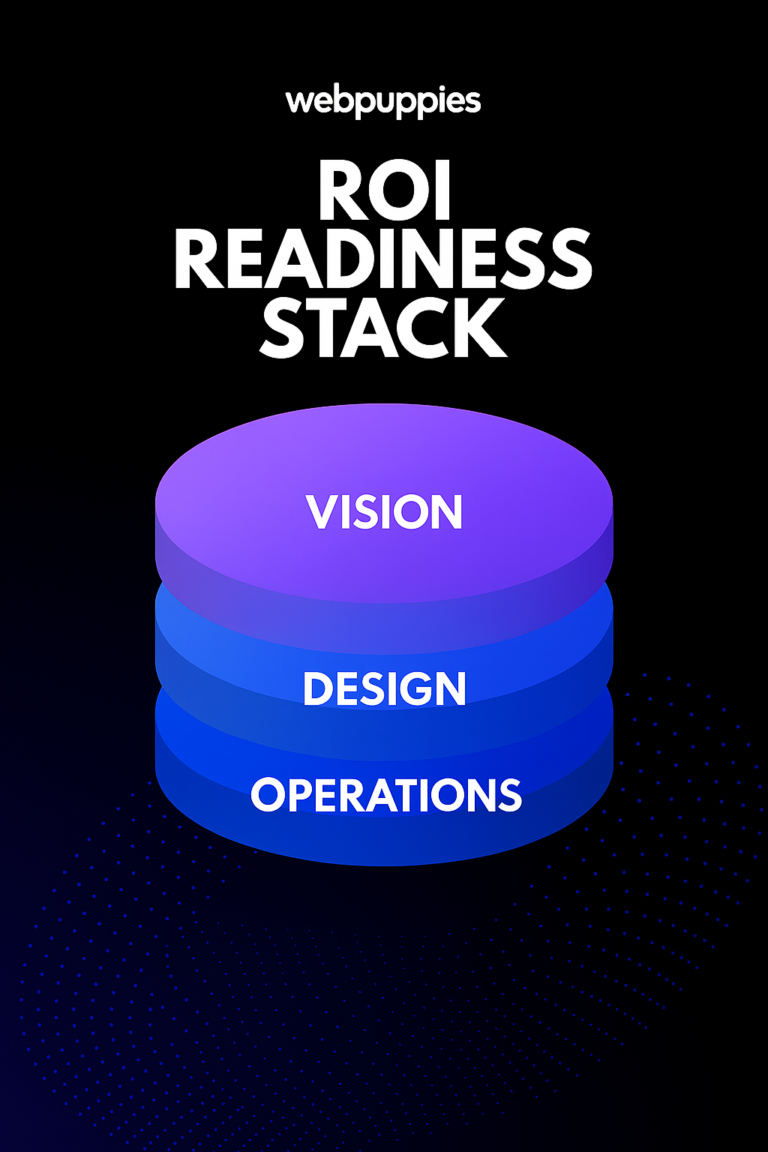Across industries, digital transformation has become non-negotiable. But the returns haven’t. Most enterprises still struggle to answer a fundamental question: Is our transformation actually delivering business value?
Investments have been made. Platforms deployed. Teams trained. But when it comes time to report impact, the numbers don’t reflect the ambition. And in too many cases, ROI remains either delayed, diluted, or completely invisible.
The reason is systemic. ROI fails in the operational layers that were never aligned to deliver measurable value in the first place.
At Webpuppies, we work with enterprise leaders to change that. We don’t start with vanity KPIs. We start by identifying the friction points, siloed processes, and legacy blind spots that quietly kill ROI long before the numbers are due.
Because when the foundation isn’t aligned, measurement becomes meaningless.
In this post, we’ll break down the real blockers to digital ROI and what to fix first before the next initiative, platform rollout, or dashboard refresh begins.
Skip to What You Need to Know
The Real Bottleneck: Why ROI Fails Before It’s Measured
The common thread in low-ROI initiatives isn’t a lack of ambition or resources. It’s a misalignment between what’s being built and how the organization actually operates. Platforms are deployed without considering how they integrate, data flows are fragmented, and user behaviors are either assumed or ignored.
As a result, leaders end up measuring progress in systems that weren’t architected to deliver visible outcomes in the first place.
In many cases, teams try to scale quickly without resolving foundational architecture debt — a mistake we’ve seen repeatedly in enterprise scaling projects.
And even when modern platforms are in place, the absence of data cohesion means KPIs reflect activity, not impact. This is exactly how data fragmentation drains ROI quietly but consistently.
ROI isn’t a byproduct of launch. It’s a byproduct of alignment — across workflows, data, and experience.
When digital systems lack this alignment, even the best KPIs fall flat. You’re not tracking impact. You’re tracking noise.
The 4 Layers That Make ROI Measurable
1. Operational Flow
Before tools, there’s flow. If your internal workflows are misaligned, digital initiatives amplify chaos instead of solving it. When processes are opaque or inconsistent, even the best platforms struggle to return value. Ask: Do people know how work moves through the system?2. Platform Fit
A platform that works in isolation rarely works in practice. High-ROI systems are integrated into the real rhythm of the organization — not just feature-rich, but context-aware. Ask: Does the tech reflect how your teams actually operate — or how vendors think they should?3. Data Confidence
Fragmented or misaligned data destroys trust. Teams revert to manual workarounds. Decisions stall. ROI disappears into untraceable metrics. Ask: Is the data connected, timely, and used the same way across functions?4. Experience Clarity
If journeys are clunky, slow, or inconsistent, users churn. Internally or externally, behavior will always expose system misalignment. Ask: Where are users dropping off, duplicating effort, or getting stuck?Lessons from the Field: What High-ROI Teams Fix First
You don’t get ROI by aiming at ROI. You get it by removing the blockers that prevent it from surfacing in the first place.
In our work across industries — finance, logistics, healthcare, and B2B tech — we’ve seen this pattern hold: high-performing teams don’t start by asking “how do we track ROI?” They start by asking “what’s standing in the way of ROI showing up at all?”
Here’s what they fix early — and why it matters:
They map the real flow before they buy the tool
Instead of retrofitting tech to broken processes, these teams trace how work, decisions, and users actually move. The result? Platforms that fit reality — not theory.
They simplify first, integrate second
No one gets ROI from chaos. Before layering in new tools, high-ROI teams remove duplication, eliminate manual patchwork, and align systems to common goals.
They make alignment visible
These teams don’t rely on dashboards alone. They build shared mental models across ops, product, and tech — so everyone sees where value is created and where it stalls.
They treat architecture as strategy
Not every change is a rebuild. But the structure of your systems determines the speed, reliability, and visibility of your outcomes. These teams optimize at the architectural level — and see ROI sooner because of it.
High-ROI teams aren’t luckier. They’re more aligned.

Metrics That Mislead vs. Metrics That Matter
One of the biggest traps in digital transformation is thinking that just because something is measurable, it’s meaningful.
Metrics That Mislead:
- Adoption counts without context
“10,000 logins” doesn’t mean engagement — it might mean friction if users are logging in multiple times to complete one task. - Tool-specific KPIs
Success metrics locked inside individual platforms hide the bigger picture. One system might show green while another is causing bottlenecks upstream. - Vanity velocity
Fast deployment timelines look great until they outpace internal readiness or create overlapping workflows.
Metrics That Matter:
- Time to decision
How quickly can leaders move from insight to action? If decisions are still delayed by data reconciliation, ROI is leaking. - User effort reduction
Are users completing journeys with fewer clicks, fewer errors, and less frustration? - System resilience
Does performance hold up under scale, stress, or change? ROI only compounds when systems are stable and scalable. - Alignment index (custom to enterprise)
How consistently are teams working from shared data, goals, and definitions of success?
When metrics aren’t connected to business outcomes, they distract more than they guide. The best teams build their measurement models from aligned operations — not vendor templates.
The Takeaway: Make ROI Visible by Design
ROI isn’t elusive because it’s hard to track — it’s elusive because the system was never built to reveal it.
Dashboards won’t fix misaligned workflows. KPIs won’t overcome fragmented data. Transformation doesn’t fail at the analytics layer. It fails when the architecture, operations, and experience are out of sync.
The enterprises that consistently realize ROI don’t just measure better — they build smarter. They design visibility into the system from day one.
Start here:
- Map how value actually moves through your organization — not how it was intended to
- Simplify before you scale
- Align technology with the flow of decisions, not just the structure of departments
Because when the system is aligned, ROI doesn’t need to be hunted. It shows up.
Ready to build a system where ROI is measurable?




